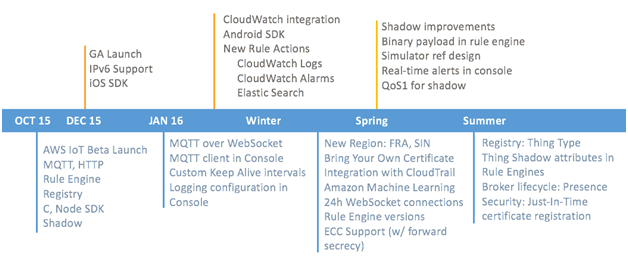IoT & Embedded Technology Blog
The IoT & Embedded Technology Beat: with Antony Passemard of AWS IoT
This interview is part of an ongoing series VDC conducts with IoT and embedded software solution providers to share views on their company, products, and state of the market.

Antony Passemard leads the strategic product management efforts for AWS IoT at Amazon Web Services. His background includes product management and business leadership at companies such as Salesforce, Yahoo! Travel, and Iniflux. Antony has over 20 years’ experience in software and entrepreneurship and holds an MBA from UC Berkeley Haas as well as a Masters in CS. Antony is passionate about building new products that deliver value to customers.
Exhibit 1: AWS IoT Innovation Timeline

VDC: The AWS IoT team has been busy since the launch of the service in October 2015. Exhibit 1 gives a good overview of major additions to the service since its inception. Which additions have customers been the most excited about recently?
Antony: Since launching AWS IoT we’ve been amazed at the level of interest and creativity shown by customers and partners, really, the breadth and depth of scenarios is quite staggering. It’s hard to single out any one feature that’s turning heads, and one consistent theme we keep hearing is that customers love the integration between the AWS IoT Service and related services like AWS Lambda, Amazon DynamoDB, Amazon Kinesis and so on. More recently, our updates focused on better Bring-Your-Own-Certificate (BYOC), and Just-In-Time-Registration (JITR) have generated a lot of excitement, given the criticality of security in this space.
VDC: Do you believe there are a handful of “killer apps” that makes cloud services appealing to customers?
Antony: IoT can drive value in virtually every vertical industry. It is amazing to see that so many customers we talk to have the potential for a killer app that is relevant to their business. A few examples are optimizing routes and pickups for a waste management company, reducing the amount of water used on lawns while keeping the grass greener, reducing cost of healthcare by enabling badge-in and badge-out of healthcare providers and improving their safety by validating identities. At Amazon we have a saying which is “It’s still Day One”, and we think this sums up the IoT opportunity perfectly. Today is just the tip of the iceberg.
VDC: Can you give me some background on IoT at AWS? Was AWS’ acquisition of 2lemetry the start of AWS’s involvement in the IoT market?
Antony: Actually, the AWS cloud was already being used widely for IoT long before AWS IoT was released, and it is through talking with those pioneering, early customers that it became clear there was a lot of common, yet undifferentiated, heavy lifting work they all had to do. AWS and 2Lemetry were very aligned, and the synergies were both complementary, and compelling. So the 2Lemetry acquisition made a lot of sense as a way for us to accelerate our ability to help customers realize their IoT goals.
VDC: Can you share a few customer examples and the value they are seeing from adopting IoT?
Antony: One of the most interesting examples right now is the healthcare platform from Philips. Philips has been running their platform on AWS but realized that as they grew, scaling and maintaining their solution was taking time and effort away from the value they could bring to their customers. Philips chose AWS IoT and many other AWS services to launch their next generation of IoT platforms and run millions of devices on it.
Another example is iRobot. This company has been a pioneer in consumer and industrial robotics. With their success, the need for a global, scalable, secure and reliable platform became very important. By choosing AWS, iRobot can deliver new experiences to their customers.
VDC: Security is always a hot topic of discussion with end users of any connected product. What steps does AWS take to make sure that IoT solutions are secure?
Antony: Security is critical for our customers and we have always made it the top priority. In IoT, where the landscape is fast changing and very fragmented, customers want the ability to create secure devices and communication channels easily. AWS IoT is a service on top of the already highly secure AWS Cloud and follows the same security patterns, like policy or role based access controls for example. Every device subscribing or publishing to AWS IoT has to follow a strict access policy. The same is true for users accessing data on AWS IoT. Every Rule that is executed in the customer’s account context is assigned a role to perform actions like posting to Elasticsearch or Kinesis. The granularity of access can go down to the attribute level of a “thing” and enables customers to control the flow of information with high precision. Encryption is also core, all devices need to use TLS1.2 and offer mutual authentication, leveraging X509 certificates. AWS IoT will generate as many certificates as the customer needs at no charge. It is not uncommon for our customers to have several millions of certificates on AWS IoT. We also offer many ways to better manage certificates and make sure there are no blockers to adoption for our customers. BYOC and JITR are two important features, that I mentioned earlier, and are differentiators for our customers and our partners. A prime example is the recently announced Microchip Zero-Touch Secure Provisioning Kit for AWS that enables very secure and seamless onboarding of vast amounts of devices on AWS IoT
VDC: Machine learning is a topic that is currently receiving a lot of attention throughout the tech world. Can you explain how the AWS Machine Learning service might be applicable to an AWS IoT customer?
Antony: IoT is so attractive to many of our customers because of the ability to leverage Machine Learning and Deep Learning on the data generated by devices. We are no longer in a world where the analysis is done at one moment in time, but in one where we can get constant data and derive much more powerful insights. AWS IoT released an integration with Amazon Machine Learning (AML) in the spring of 2016. Customers can use the Rules Engine to send any payload coming in to an AML model, get the prediction from that model and plug it in the payload before it is sent down to another service, or republished to another topic for further analysis based on the result. Thanks to the different types of models AML features (binary classification, Multiclass classification and regression) it is possible for our customers to make quick decisions on the data coming in, such as “Should this device receive a maintenance visit?”, “Is this data out of bound?”, “What is the expected value of a particular attribute?” and more.
VDC: Is there anything else you’d like to leave us and our readers with today?
Antony: IoT is maturing quickly but we are really just at the beginning of what is possible. Every day we work hard to help customers’ solve their challenges, and our rate and pace of innovation keeps accelerating, so you can expect to see continued rapid innovation. Our partner ecosystem is also growing fast, with companies like C3 IoT, BSquare or Solstice Mobile that can help our customers bring their project to reality.
View the 2017 IoT & Embedded Technology Research Outline to learn more.